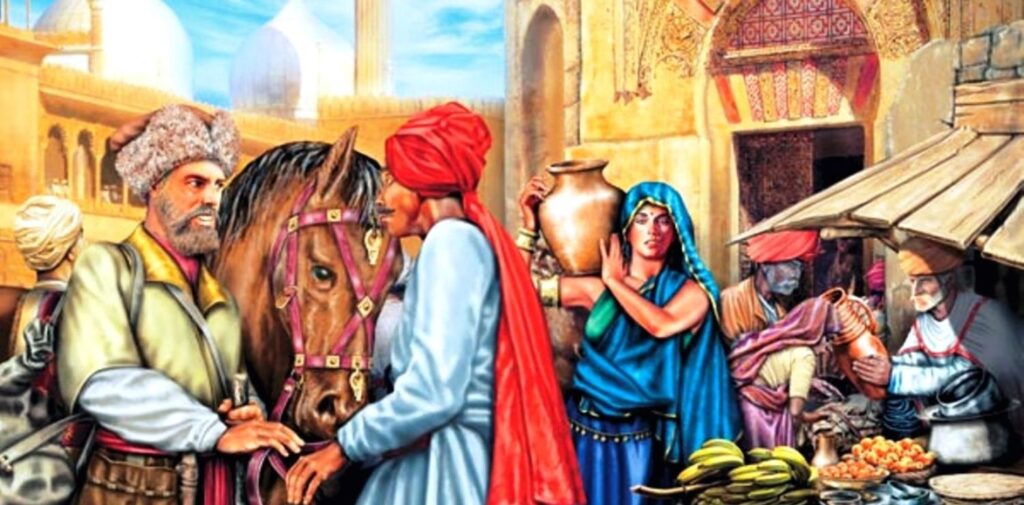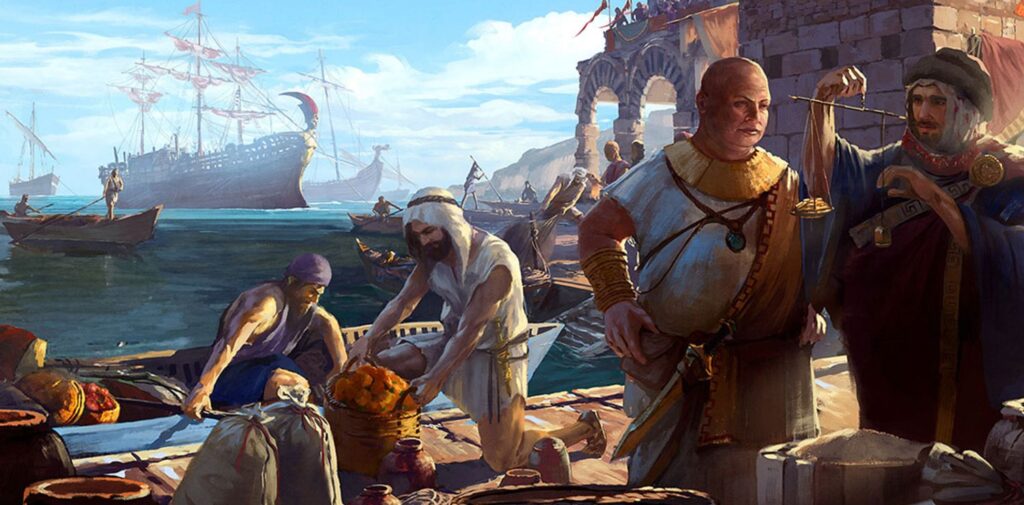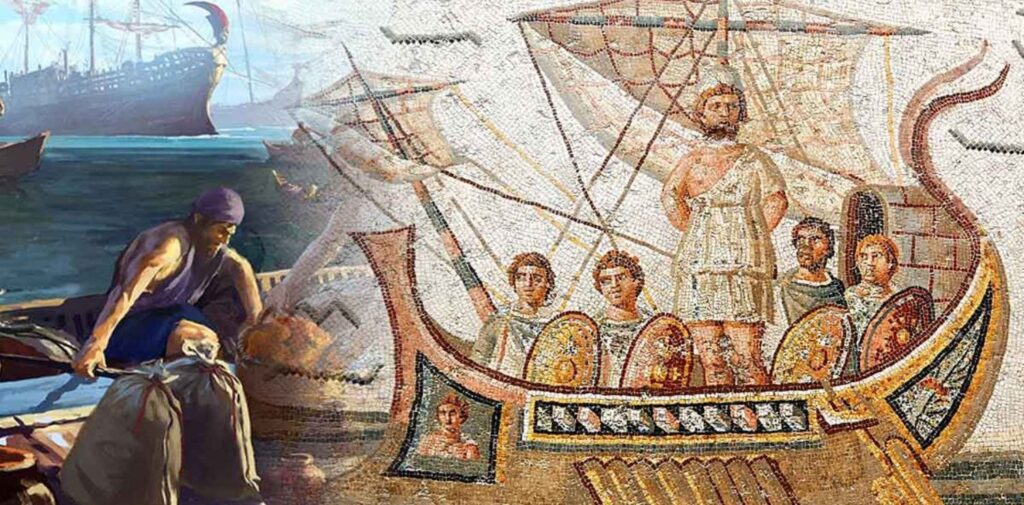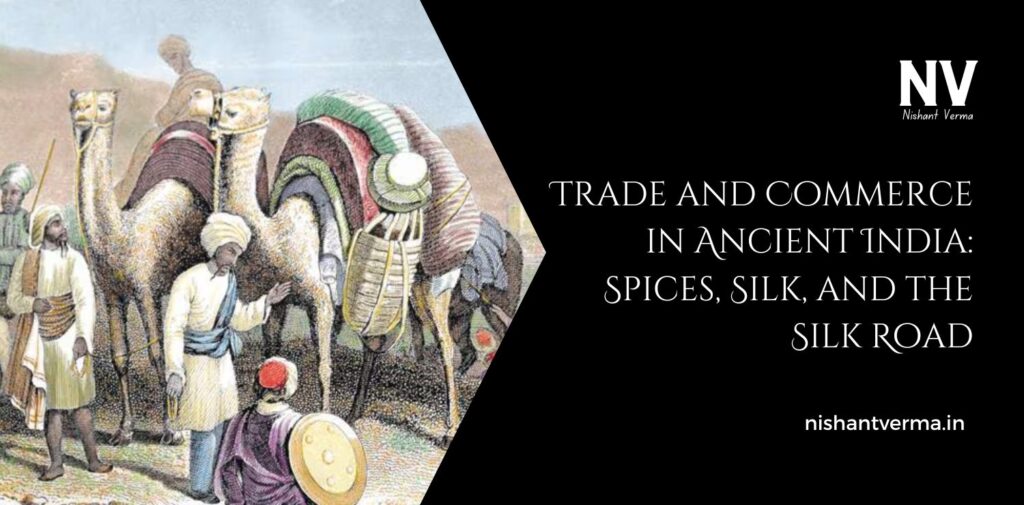Trade and Commerce in Ancient India played a very important role in shaping the economy and connecting different parts of the world. India was not only known for its rich culture and heritage but also for its valuable goods, such as spices, silk, and precious stones. These goods were highly sought after by people from other countries, and this led to the growth of trade networks. One of the most famous trade routes that passed through India was the Silk Road, which connected India with distant lands like China, Rome, and the Middle East. Let’s explore how trade worked in ancient India, with a focus on spices, silk, and the role of the Silk Road.
The Importance of Trade in Ancient India
Trade in ancient India was not just about exchanging goods; it was also about sharing knowledge, culture, and ideas. People from different parts of India would travel to markets and trading centers to buy and sell products. Traders used various routes, including sea routes and land routes, to carry their goods to different parts of the world.
India was in a great position for trade because it was located between important civilizations. To the west was the Roman Empire, and to the east was China. India became the middle point for many goods and ideas to flow between these two places.

Spices: The Jewel of Indian Trade
One of the most famous and valuable goods that ancient India traded was spices. Spices were used for many purposes: to add flavor to food, preserve it, and even for medicine. Some of the most popular spices that India exported included black pepper, cinnamon, cardamom, turmeric, and ginger. These spices were so valuable that they were known as the “black gold” of ancient trade.
India’s spice trade dates back thousands of years. The Malabar Coast in southwestern India was famous for growing many types of spices. The spice trade was not only important within India but also connected India to countries like Egypt, Rome, and even China. Traders would travel long distances to bring spices from India to different parts of the world.
The spice trade made India an important hub in global commerce. People from Europe and the Middle East would come to India specifically to buy spices. These goods were exchanged for products like wine, glassware, and gold, which were valuable to Indian traders.
Silk: The Luxury Fabric of India
Another important item in ancient Indian trade was silk. Silk was a luxurious fabric made from the silkworm. It was light, shiny, and beautiful, which made it highly desirable in many countries. While China is often thought of as the birthplace of silk, India also played an important role in its production and trade.
In India, silk was mainly produced in places like Banaras and Kanchipuram. These areas were famous for weaving beautiful silk clothes that were popular among kings and queens. The quality of Indian silk was very high, and it was in great demand in places like Rome and Persia.
Silk was one of the goods that traveled along the Silk Road, a famous network of trade routes that connected India to China, the Middle East, and even Europe. This road allowed for the exchange of not just goods but also ideas, technology, and culture. Traders would travel with silk, spices, and other products, sharing stories and knowledge as they went along.
The Silk Road: A Bridge Between Cultures
The Silk Road was not just one road but a series of connected routes that stretched across Asia, linking India to China, the Middle East, and Europe. These routes passed through deserts, mountains, and seas, and traders traveled on foot, camels, and ships.
India was a key player in the Silk Road trade. The country was located at the crossroads of important trade routes, making it an ideal place for merchants to gather, trade, and exchange goods. Traders from India would travel to cities like Bactra (in modern-day Afghanistan) and Samarkand (in modern-day Uzbekistan), where they would meet traders from other countries.
The goods that India exchanged on the Silk Road were not just spices and silk. India also traded precious stones, cotton, and indigo. In return, India received goods like gold, silver, wool, and glassware. This exchange of goods helped India to become wealthy and prosperous.
The Silk Road also allowed for the exchange of ideas. Through this route, Buddhism spread from India to China, Central Asia, and beyond. Indian scholars and monks traveled along the Silk Road to share their teachings, while at the same time, they learned new ideas and technologies from other cultures.

Sea Trade: India’s Connection to the World
In addition to land routes, ancient India also had a strong presence in sea trade. India’s long coastline allowed traders to travel by sea to other parts of Asia, Africa, and the Arabian Peninsula. The Indian Ocean became a major highway for trade, and many ports in India, such as Kochi, Musiris, and Surat, became bustling centers of commerce.
Indian merchants used ships to carry goods across the seas to places like Egypt, Persia, and even the coast of East Africa. They also sailed to Southeast Asia and China. The Indian Ocean trade routes allowed for the exchange of not just goods but also culture and ideas between India and other parts of the world.
One important product that India traded by sea was pearls. India’s southern coast was known for producing beautiful pearls, which were in high demand in the Roman Empire. Indian ships would also carry spices, textiles, and precious stones to faraway lands.
The Role of Ancient Indian Kingdoms in Trade
Trade was an important part of the economy for many ancient Indian kingdoms. The Maurya Empire, for example, controlled a large part of the Indian subcontinent and encouraged trade with other regions. King Ashoka, one of the greatest Mauryan rulers, promoted the spread of Buddhism along with trade, using the Silk Road as a way to connect with different parts of the world.
The Gupta Empire, known for its achievements in science, mathematics, and culture, also played an important role in trade. The Gupta period saw the growth of Indian commerce, especially with countries in Southeast Asia and the Mediterranean.

Why Trade Was Important for Ancient India
Trade in ancient India was important for several reasons. First, it helped to bring wealth and prosperity to the people of India. The exchange of goods like spices and silk made India one of the richest and most influential countries in the ancient world.
Second, trade connected India with the rest of the world, leading to the exchange of ideas, cultures, and religions. The spread of Buddhism, for example, happened because of trade routes like the Silk Road. Similarly, new inventions and technologies were introduced to India through trade.
Finally, trade helped build strong relationships between different civilizations. Traders, pilgrims, and travelers from different cultures met along the trade routes, which led to the sharing of knowledge, traditions, and customs.
Conclusion – Trade and Commerce in Ancient India
In ancient India, trade and commerce were vital for the country’s growth and development. Spices and silk were some of the most valuable products traded across the world, and India’s location on the Silk Road made it an important center for exchange. The Silk Road not only allowed for the exchange of goods but also helped spread ideas, culture, and religion across vast distances.
Today, we remember the importance of trade in ancient India because it helped build connections between people and created a rich cultural heritage. The legacy of India’s ancient trade networks continues to influence the world today, showing us the power of trade in bringing people together.




